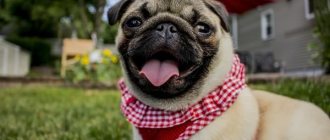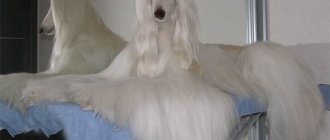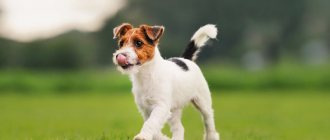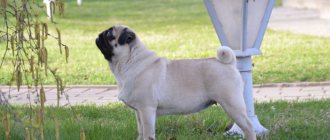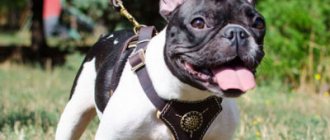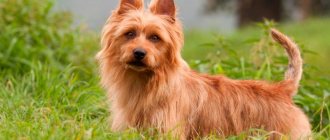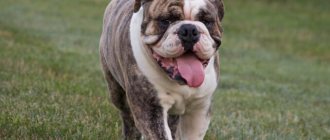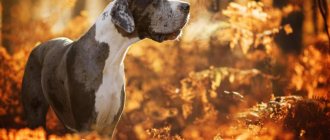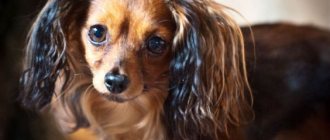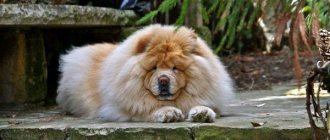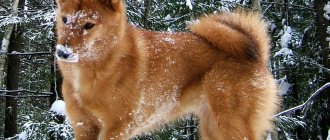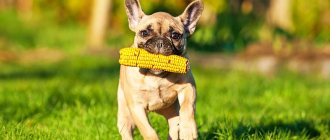Care and maintenance
In general, a dog requires the same care as any other. Natural health and the absence of genetic diseases do not create great difficulties in maintenance.
It is recommended to take into account the southern origin of the breed and take care of a warm bed, protected from drafts. In cold weather, you will need warm clothes for your pet. Physical activity promotes a healthy lifestyle and prevents dog obesity. Her appetite is always excellent.
Short hair requires minimal grooming. Regular brushing of the dog, about once a week, is necessary to remove dead hair. Large ears need cleaning to avoid inflammation and otitis media.
It is advisable to accustom the Cerneco del Etna puppy to trimming its nails from an early age, otherwise it will desperately resist. Grinding of claws can be achieved naturally only with systematic exercise and walks in nature.
An independent character requires proper training and a firm hand from the owner. With constant communication, the dog is able to capture even the mood of its companion. Buying a Cerneco del Etna puppy means finding a pet and a companion for family walks for 12-15 years. This is the lifespan of a dog.
Content Features
Cirneco del Etna are great for living in an apartment or house, they are neat and clean. Do not require complex care. Options for living in an enclosure, and especially on a leash, should not be considered at all. Firstly, this is a short-haired dog that is sensitive to cold and dampness. Secondly, this is a hunter who needs close contact with the owner and the greatest possible freedom. It is better to arrange personal space in the house on a hill. Cirneks prefer armchairs, sofas and the owner's bed, but you can also teach your puppy to sleep on his own bed from an early age.
Physical and mental stress must correspond to the activity of the dog. Normal mode - 2 walks lasting 30-45 minutes, full of active games with the owner or relatives and the opportunity to run freely. A Sicilian Greyhound can only be let off a leash in a fenced area, such as a park or outdoors, provided that it is trained to return on command, monitors its owner's whereabouts, and will not run very far.
It is rare among the Cirnecas to find pigs that wallow in the first puddle they come across. More often they proudly walk along the dry sidewalk and love warmth and comfort. With the onset of the first cold weather and wet windy weather, it is better to insulate the dog.
The overalls will save you from hypothermia, dirt and daily washing. In windy and frosty weather, the chirnek ears should be protected from chapping and hypothermia with a hood.
Hygiene and care
The pet is unpretentious in care and maintenance. The pet is smooth-haired, so brushing it with a special brush with stiff bristles is sufficient no more than once a week. The animals are clean and therefore do not have an unpleasant odor. They should be bathed rarely. For example, pets that take part in various exhibitions are bathed no more than once a month.
The animal's ears require close attention.
It is important for dogs to clean their ears regularly, as secretions that accumulate in them can cause inflammation of the middle ear. You also need to trim your nails regularly.
Nutrition
Most Cirneque breeders and owners prefer to feed their dogs natural products using the BARF system. This diet is considered as close to natural as possible and meets all the needs of the animal. You can also choose high-quality dry food if you wish. Cirneco food is suitable above the super-premium class for active small and medium-sized dogs. In addition, it must correspond to the age (for puppies, juniors or adults) and the physiological state of the dog (pregnancy, lactation).
Advantages and disadvantages
Cirneco is a dog breed that has a fairly extensive list of advantageous features, thanks to which it is so valued in its homeland:
- unpretentious pets;
- curious and easy to learn;
- have an affectionate and affectionate character;
- typical hunter's temper;
- active and inquisitive until old age, so they need to devote a lot of time.
Another significant advantage is that dogs do not have an undercoat, therefore, the animals have no odor and the likelihood of developing an allergic reaction in household members is very small.
Despite a number of advantages, there are also disadvantages:
- hind toes dewclaws;
- short dewlap and neck;
- short muzzle;
- divergence of the muzzle and skull.
Dogs can be touchy at times. If the owner has offended his pet, the latter may stop obeying and carry out even the most primitive commands.
Maintenance and care
Since the Sicilian Greyhound comes from warm islands, it can live exclusively in an apartment. If you live in a house and own the adjacent territory, this is only a pole, but the pet should sleep and spend most of the day in the home. Suitable for apartment living. Its owner must lead an active lifestyle.
Representatives of the breed are very sensitive to cold. Such dogs catch a cold almost instantly, so the owner must provide the ward with:
- A warm lounger with sides, raised from the floor, not located in a draft. According to the experience of most owners, the optimal lounger for Cirneco del Etna is a sofa with a blanket.
- Winter clothes, scarf, hat and shoes.
- Demi-season clothes.
- Raincoat with lining.
- Home clothes and socks for the winter period (relevant for homes without devices for monitoring the temperature of radiators).
The Sicilian Greyhound needs dynamic, but not too long walks in the cold season. In summer, walking time can be increased until it is comfortable for the dog. In autumn and spring, it is advisable to engage your pet in active sports. Dog sports are an excellent alternative to monotonous games while walking. By exercising on the site 2-3 times a week, the dog will maintain physical fitness and good health.
Coat care is not difficult - brushing once a week. The shedding of Cirneco del Etna is almost unnoticeable. Bathing is carried out as needed; for quick cleaning, the coat can be wiped with a damp cotton towel. Inspect daily:
Eyes – wipe with a sponge if necessary.
Ears - strictly monitor the condition, as the breed is prone to otitis media.
Nails - the trimming procedure can become a problem, since an adult pet vehemently protests and even bites when the nail clippers approach. Accustom your puppy to trimming its claws from an early age; if the procedure is not required, simply touch each claw with the accessory and squeeze the handles.
Teeth - usually Cirneco del Etna does not have problems with teeth, but if there is a malocclusion, chips and inadequate feeding, caries, pulpitis and other unpleasant diseases of the oral cavity are possible.
Eating Cirneco del Etna is a rather painstaking process. There are simply no general recommendations, since most of the dog population ends up in the hands of fans of the breed. Newcomers from Cirneco del Etna have experience in raising other breeds, which they try on the native four-legged animals.
Empirically, the owners have found that the optimal type of feeding is natural. Moreover, raw foods, including vegetables, are more beneficial for Cirneco del Etna. Beef tripe and soft cartilage are in great demand among four-legged animals. A puppy should be taught to eat raw vegetables from childhood, since the dog’s body needs fiber and its teeth need natural cleaning. Some owners also speak positively about feeding meat porridge with the addition of vitamin complexes.
Experience shows that each dog's taste preferences are individual. One four-legged animal loves vegetables, another loves fruits, the third prefers only meat. Owners describe how their dogs eat whole bowls of fruit and refuse meat. The Cirneco dell'Etna is a born hunter, and its natural diet is rabbit meat. Early members of the breed survived for generations by hunting on their own and snacking on whatever they found in season.
So, if you decide to have a Cirneco del Etna, then the rabbit should become the basis of the diet. The benefits are obvious:
- Dietary meat is a source of protein, fatty acids and amino acids.
- Soft bones and cartilage.
- The liver and stomach are a source of vitamins, fiber, iron, and beneficial bacteria.
Best articles: Interesting facts about reptiles
When feeding in urban conditions, rabbit is partially replaced with beef and poultry (without bones). Half of the entire portion of food should be occupied by the stomach, preferably it should not be washed. The smell is still the same, but the benefits are obvious. If you do not have the opportunity to buy rabbit stomach, you can resort to an alternative - buy beef or sheep tripe.
Regarding industrial feeding, most reviews are negative. Even the highest quality and most expensive food is perceived by Cirneco del Etna without much enthusiasm. The dog does not refuse food, looks good, remains healthy, but does not enjoy the process of eating.
Nutrition
This is perhaps the only breed that needs a varied diet. Meat products should predominate in the diet, complemented by grains and vegetables. It is also recommended to regularly pamper your pet with raw fruits and offal.
How does the Sicilian Greyhound hunt?
Note! Ready-made industrial feeds are mainly used during training as a reward.
No genetic diseases have been documented in the Sicilian Greyhound. But it is important to know that dogs are predisposed to developing colds, as well as ear problems. Healthy representatives of the breed live on average from 12 to 15 years.
Photos of Cirneco del Etno
Sources
- https://pets2.me/bok/656-ekslyuzivnaya-i-redkaya-poroda-sobak-chirneko-del-etna.html
- https://rybki.guru/uhod/chirneko-del-jetna.html
- https://dog.pet2me.com/ru/breed/Chirneko_del_Yetna
- https://givotniymir.ru/chirneko-del-etna-sobaka-opisanie-osobennosti-uxod-i-cena-chirneko-del-etny/
- https://cirneco-volgograd.ru/puppies.html
- https://sobakainfo.ru/chirneko-del-etna-foto-opisanie-i-harakteristika-porody-uhod/
- https://zveri.guru/zhivotnye/sobaki/porody-sobak/siciliyskaya-borzaya-chirneko-del-etna-osobennosti-uhoda-i-soderzhaniya.html
Diseases
Due to their natural origin, Cirnecos have very good health and are among the longest-living dogs, living about 15 years.
It is important not to ruin your health, for example, by poor nutrition
There are some care features to maintain health:
- Cirnecos are sunny dogs, and in some regions there is little sun, which requires additional vitamin D to be added to the diet, after consulting with a veterinarian.
- Cirneco dogs are naturally accustomed to warmth, and in very cold climates with sub-zero temperatures, the use of clothing is necessary for them. But you shouldn’t be zealous - excessive care is harmful to health, with slight cold snaps dogs adapt well, and there is no need for clothing.
- Like other breeds, Cirnecos are susceptible to infectious diseases, so all necessary vaccinations must be done regularly.
Health and life expectancy
Cirneco del Etna are considered extremely healthy dogs. Of course, they can suffer from various infectious and non-communicable diseases, as well as get sick as a result of improper care and nutrition, but genetically the breed is safe. Veterinary preventive measures (vaccination, treatment against parasites, routine medical examination) are mandatory to maintain health.
Cirneco del Etna are very hardy, they are able to work for several hours without water or food in the scorching sun. However, this does not mean that the dog needs to be constantly exposed to extreme conditions. This only tells us why they were bred and in what conditions they can work, and not in what conditions they must live permanently. Life expectancy is usually 12-15 years.
Description of the breed
Cirneco dell'Etna has a thin build. With a height at the withers of 42–52 cm, their weight reaches 8–10 kg. However, the dogs do not look exhausted. They have a keen sense of smell and excellent vision. Like all greyhounds, representatives of the breed run quickly and move easily. Since Sicilian dogs are now most often used as family pets, it is worth knowing what their temperament is.
External features of the structure
Typical representatives of the breed are shown in the photo. When examining the images, the external structural features of the cirneco are clearly visible:
- The head is elongated with a straight nose. The size of the skull between the arches of the cheekbones does not exceed 1/2 the length of the entire head. The transition from the line of the forehead to the skull is smooth.
- The eyes are small. Their color depends on the color of the animal - gray or amber.
- The ears are set high, long, erect. Their ends are pointed.
- The lips are thin and fit tightly to the jaws.
- The body is muscular, elongated. The neck is half shorter than the head, the skin does not hang down on it. The back is straight, the lower body is thin but muscular.
- The limbs are thin, straight, the front ones are parallel to the rear ones. The toes are tightly clenched. Nails are brown or flesh-colored.
- The tail is of equal thickness along its entire length and is set low. In a calm state, it has a saber-shaped shape; when alert, it stands upright.
Coat type and color standards
The Greyhound from Sicily has a short, coarse coat without undercoat. It fits tightly to the body. The fur on the limbs is shorter than on the body, head and tail. According to the standard, dogs have the following types of colors:
- Solid fawn. Colors are possible, both standard pronounced and muted, for example, sable.
- Red with white spots on the paws, chest, head, abdomen and tip of the tail.
- Pure white.
- White with red spots.
Temperament of the Sicilian Greyhound
Animals are sociable and friendly. They are attached to their owners, but try to maintain independence. They do not tolerate rude treatment or physical punishment. If a dog is constantly shouted at, he ceases to perceive the offender. The Sicilian Greyhound loves to play and does not tolerate loneliness. When she is bored, she can damage the owner's property.
If a puppy grows up with a child, he perceives him as his friend. Enjoys taking part in children's entertainment. Tries to accompany the baby at all times. However, if a child is born after a dog appears in the house, the pet shows indifference to him until he can play with him.
The dog greets strangers with a wagging tail, so it cannot be a guard. Relationships with other pets depend on their size. The greyhound is wary of large pets, sooner or later it begins to hunt small ones, and is friends with dogs of equal size. However, if the dog notices that someone is trying to take a leading position or is encroaching on his food, he is capable of provoking a fight.
Appearance - color and size
The Cirneco dell'Etna is a hunting breed of dog whose main purpose is to hunt down rabbits, hares and foxes. This is an elegant, fine-boned animal, whose peculiarity is its elongated body proportions.
Description of the breed:
- Dimensions: height of males - up to 50 cm, females - up to 46 cm, weight of males - up to 12 kg, females - up to 10 kg.
- The head is elongated, the skull is slightly convex. The transition from the forehead to the muzzle is smooth, weakly expressed. The muzzle is long, tapering towards the nose. The bridge of the nose is straight and thin. The lobe is rectangular, pigmented, nutty or brown. The lips are thin and fit well to the jaw. There are no wings. Scissor bite. Full set of well developed teeth.
- The eyes can be small or large, light brown or amber. Eyelids are pigmented.
- The ears are triangular, set high, and pointed at the ends. The neck has good muscle tone, blends gently into the body, its length is comparable to the size of the head.
- The body is square, dry, lean. The dog is not prone to obesity and has an elegant physique. The back is straight, the croup is medium in size, the stomach is tucked.
- The tail is saber-shaped, thick, with short hair.
- The limbs are fine-boned, straight and strong. The claws are flesh-colored or brown.
- The coat is short, smooth, 3 cm longer on the body and tail. The structure is similar to that of a horse's coat.
Colors:
- pale yellow;
- sable;
- Isabella (coffee with cream);
- ginger;
- white;
- white with red spots.
The standard allows white spots on the chest, head, tail, paws and belly. Red markings are within the normal range, but in practice they are not welcome at shows.
Isabella color resembles the color of an unwashed nightgown. It got its name from Queen Isabella of Spain, who promised not to wash her shirt until her husband Albrecht VII took the city of Ostend. According to another version, she simply loved the straw color. Isabella is a pale yellow with a pinkish tint.
Characteristics of Cirneco del Etna dogs: features of the Sicilian greyhound breed
The Cirneco dell'Etna dog breed has lived on the island of Sicily for more than 2,500 years. Its other name is the Sicilian Greyhound. Due to its physiological characteristics, it is used for hunting hares and rabbits. Little is known about this breed outside the island, but in recent years in Russia there have been more and more people interested in such pets.
History of the breed
The Sicilian Greyhound is considered one of the most ancient breeds, it has much in common with other Mediterranean canines, for example, the Podenco Canario, the Ibicenco Podenco or the Pharaoh Hound from Malta.
Sicilian Greyhound
Most linguists believe that "cirneko" comes from the Greek word "Kyrenaikos", which was the name of the ancient Syrian city. That is why there is an opinion that the breed comes from the Middle East, and was already brought to Sicily by Greek merchants from North Africa.
Note! The results of numerous genetic studies have shown that the Pharaoh Hound has virtually nothing in common with the greyhound
Cirneco del Etna: description of the breed and character
Greyhound (dog): description of the English greyhound breed
Other common names for the breed are Sicilian Greyhound, Sicilian Greyhound, Cirneco dell'Etna and Sicilian Hound.
Difficulties in care and maintenance: animals do not tolerate low temperatures and especially dampness; pets must be insulated for the winter.
You should also carefully monitor the condition of your pet’s claws and trim them properly in a timely manner.
Cirneco white color
Brief characteristics of the breed:
- Height ranges from 46 to 50 cm.
- Life expectancy under good conditions ranges from 12-15 years.
- Weight 10-12 kg.
- The breed is short-haired, no more than 3 cm long, smooth and fits tightly to the skin.
- The color is even, rich red. White and white with red tan colors are also acceptable in the breed. All shades of ocher and fawn are also allowed.
Pets of this breed have an independent and strong character. Despite this, they easily make contact with people and other animals and are very attached to their owners. An important factor when choosing a pet for the family is that the greyhound has a stable psyche and gets along well with children. This dog is exclusively domestic, despite his activity and need for games.
Note! Cirneco del Etna are not prone to loud barking and fuss. Despite their small size, they are not decorative breeds
Hygiene and care
Russian greyhound dog: description of the hound breed
Best articles: Formation of daughter chromosomes as a result of mitosis and meiosis
The pet is unpretentious in care and maintenance.
The pet is smooth-haired, so brushing it with a special brush with stiff bristles is sufficient no more than once a week. The animals are clean and therefore do not have an unpleasant odor.
They should be bathed rarely. For example, pets that take part in various exhibitions are bathed no more than once a month.
The animal's ears require close attention.
It is important for dogs to clean their ears regularly, as secretions that accumulate in them can cause inflammation of the middle ear. You also need to trim your nails regularly.
Who is the Sicilian dog suitable for?
The Sicilian Greyhound is suitable for apartment living
But it is important that the owner leads an active lifestyle. As practice shows, the breed is ideal for athletes and hunters. The pet should not be left alone at home for an extended period of time.
The pet should not be left alone at home for an extended period of time.
Sicilian greyhound puppy
Note! The dog is friendly, but with the appearance of children in the house, you should not count on its 100% obedience. Pets often become jealous, so breeders recommend holding off on purchasing a dog until your children are older. In an apartment the animal gets along with other pets, but on the street at any convenient time it can chase another dog or cat
In an apartment, the animal gets along with other pets, but on the street at any convenient time it can chase another dog or cat.
How much does it cost and where can I buy it?
Dogs do not tolerate cold well, so they are not very common in Russia. However, in Moscow there is a National Breed Club where you can purchase a purebred puppy. The price of a dog ranges from 50-70 thousand rubles.
Sicilian greyhound mother
Character and behavior
Cirneco del Etna are very energetic, intelligent, sociable and playful. They are strongly attached to all family members, loyal and obedient, but at the same time very demanding. They must always be at work under the guidance of the owner; they will not entertain themselves or sit at home and be content with short walks. If a dog does not throw out all its energy on the street, it stops obeying and becomes destructive. Cirneki remain bold until old age. To a lesser or greater extent proud and independent.
In many countries, Cirneks take part in coursing competitions and often become champions. They can also be found at rabbit field trials and competitions in agility, flyball, and freestyle.
With all the charm and attractiveness of Cirneca, one should not forget about its purpose. A passionate hunter by nature must be stubborn and persistent, capable of high concentration and passion for pursuit. Cirneco del Etna work like hounds (on scent) and like greyhounds (on sight). Bitches usually have a more pronounced hunting instinct, but males are also ready to run after a target at any moment.
On the one hand, such qualities as energy, a pronounced instinct of pursuit and anger towards the animal are useful. They allow you to raise excellent coursers or use enthusiastic, fast dogs for hunting. But they also come with the challenges of keeping Cirneques in urban environments, where birds and neighborhood cats abound and cars pop up around every corner.
Cirneks become strongly attached to their owner and suffer during separation or prolonged loneliness. They may be offended if they feel that they have been unfairly treated. They can be stubborn and prefer to make their own decisions. However, you should not allow this to happen in all life situations, nor should you over-pamper your dog. As a result, she may consider herself the leader in the family, which is fraught with various behavioral problems. Puppies that have undergone proper social adaptation are very good with children, without aggression. They are not afraid of kids, they know when it is better to step aside.
Cirneki bark rarely, mostly when excited or when they demand something. They are very curious by nature and should always be in the center of events. They will be happy to accompany the owner everywhere. They are interested in absolutely everything, the people around them, dogs, everything that lies on the ground, runs or flies.
They get along well with other animals, family members, dogs and cats, are not aggressive, but may try to dominate. Very large dogs are often feared. Those who fit their size are played with with pleasure or ignored. True, they can provoke a conflict due to the division of territory, food or attention.
Choosing a puppy
According to the unspoken but generally accepted rules for choosing a puppy, you should adhere to the basic principle. Of all the strong, active and playful puppies in the litter, you should choose the average one, not the large one, or vice versa, the quietest and smallest dog child. The puppy should not have any signs of rickets. If the stomach is swollen and it is not rickets, you should ask when the puppies were last dewormed, and immediately deworm them upon arrival home. At two months, puppies look the same as they will look as adults. At eight weeks you can see a miniature copy of an adult dog in front of you.
Therefore, it is highly desirable to have a visual acquaintance with the parents of the litter, where you can carefully examine both the mother and the father of the glorious family. The puppy you have chosen must have the following documents: a birth certificate certified by the breed club; veterinary passport, which contains the dates of vaccinations, according to the age of the baby; an implanted chip or brand, or possibly both; pedigrees of mother and father; parental health certificates. As a rule, the breeder provides detailed recommendations on raising and feeding the puppy in writing, and leaves his contact details so that the new owner can contact him without delay in emergency or unusual cases.
Personality of the Sicilian Greyhound
The “Sicilian” is an excellent hunting dog with an energetic temperament and at the same time a peaceful, flexible and affectionate character. This is a cheerful and cheerful creature, with an affectionate and playful behavior. Cirnecos are very inquisitive and curious, get along well with other dogs and do not strive for dominance in relationships with humans. They remain somewhat wary of strangers, which, with certain training, allows them to be very smart watchmen and security guards.
They perfectly sense the human condition and never overly impose their company, rarely bark, which makes them excellent companion dogs. They love to travel. They are able to accompany the owner for a long time on walking and cycling trips.
Cirneco greyhounds are very intelligent and easy to train, especially if the training looks like a game or is rewarded with affection and treats. The “Sicilian” is independent and independent, which also needs to be taken into account when raising her.
Training
Raising Sicilian Greyhounds begins with early socialization. Puppies need to get used to dogs and strangers, so it is recommended that they go to parks and dog parks with them. Cirneco needs a firm and principled owner who can achieve unquestioning obedience from them. These dogs are easy to train, but are often stubborn. It is better to learn commands in a playful way, offering your pet a treat or toy as a reward for good behavior.
Sicilians cannot be forced! They will not tolerate physical punishment and will forever remember the insult.
Training should be varied, otherwise the pet will lose interest in training with the owner. You should not overload your dog with excessive activity; it is better to take him for a bike ride or a morning jog.
Caring for the Sicilian Greyhound
The Cirneco is quite unpretentious in its maintenance, in particular, it does not require special foods for nutrition, and the daily food intake is from 2 to 3% of the dog’s body weight. Avoid monotony. And there is plenty to diversify the menu. Introduce into your diet:
- raw meat and offal;
- bones (necessarily raw), preferably from a hare, rabbit or bird;
- vegetables and fruits;
- cereals;
- dog food.
Avoid monotony of food by combining the listed products in different combinations.
Monotonous food will sooner or later worsen the well-being and appearance of your pet. Important! When forming a dog’s diet, keep in mind that boiled and stewed bones often have (or form sharp chips during crushing with teeth). As a result, your pet may injure the soft tissues of the mouth. Dull, matted hair and (or) hair loss is a clear sign of a dog’s illness or monotony of food.
Review the diet (for example, giving Cirneco a choice of different foods) or show your pet to a specialist
Dull, matted fur and/or hair loss is a clear sign of a dog’s illness or monotony of food. Review the diet (for example, giving Cirneco different foods to choose from) or show your pet to a specialist.
Bathing and hygiene
The short, coarse coat of the Sicilian Greyhound also does not require special care and does not cause trouble during the period of rather light shedding. This hunting dog is a good swimmer and tolerates bathing well.
Screening for infections
Infectious diseases occur in almost all dog breeds and are caused by a number of reasons, the main one of which is contact with an infected animal. An organism weakened by an improper regimen or poor nutrition is more susceptible to one or another infection. There are many signs of the disease, for example:
- lack of appetite;
- dull look;
- chills (shivering);
- copious discharge from the eyes, nostrils, mouth;
- unusual thirst;
- weak mental tone (lethargy) or excessive aggressiveness;
- digestive disorders (vomiting, diarrhea);
- hard breath;
- elevated temperature.
If you see these signs of illness, contact your veterinarian immediately.
If your body temperature is elevated, this should be done as soon as possible. Very often, to avoid death, you will have no more than six hours at your disposal. To prevent dogs from becoming infected, vaccinate them in advance. Important! The metabolism of dogs, especially small and medium-sized ones, is different from that of humans, so all acute diseases develop very quickly. For example, with pneumonia or carnivore plague, Cirneco can “burn out” within 24 hours from the active phase of the disease, that is, from an increase in body temperature
About health
The Sicilian dog takes root normally in Ukraine, so the local climate does not bother it. As befits hunting dogs, it can withstand both heat and negative air temperatures (down to 25 degrees below zero), but it is not recommended to leave it in the cold for a long time. Specific diseases inherent to the Cirneco breed have not been discovered by either foreign or domestic veterinarians.
In general, the slightly exotic greyhound dog from Italian Sicily has the most common physiology and psyche, which allows it to live normally in our country. Special care is required to the same extent as local greyhound hunting dogs. Cirneco will feel comfortable in any home (apartment, cottage, town house, mansion) and will faithfully serve you all his life.
Best articles: What is a river system called in geography? Definition, examples and types
Nicknames and names
All purebred puppies have nicknames, but their owners give them pet names. Names, as a rule, do not appear in reporting and are used at the everyday level.
Suitable names for male dogs: Borat, Vaiden, Are, Kato, Lyman, Hesper or Wacker.
Nicknames for bitches: Besi, Nelda, Dixa, Lima, Brigita, Jassy, Verity.
The Sicilian Greyhound breed has many advantages, thanks to which it is so highly valued in its homeland. The pet is unpretentious in caring for and raising, but it is better to have one for an active family.
Acquisition and nurseries
There are few kennels in Russia that breed Sicilian greyhounds. Even though these dogs are not fussy to care for, the task facing breeders is difficult. They must prevent representatives of this breed from developing characteristics that are unusual for them. The dogs must remain as similar as possible to their island ancestors. Selecting such puppies from a litter is a difficult task. In the case of the Sicilian Greyhound, you need to look only at the totality of parameters. After birth and rearing, the litter is divided into three categories:
- Puppies that best meet the breed standard are sent for breeding. They remain in the nursery or are handed over to experienced owners. Such puppies are prized, so international sales are not uncommon. The price for a show-class puppy starts from 200,000 rubles.
- Puppies with minimal deviations from the standard can also participate in shows and breed activities, but are not allowed to breed. Such dogs belong to the exhibition class, their price is about 100-150 thousand rubles.
- Puppies that do not meet the standard in many respects are sold to ordinary hobbyists. It is forbidden to cross them with each other, so most often they end up with new owners after castration.
If a person, after familiarizing himself with the pros and cons of the Sicilian greyhound, still decides to purchase, it is highly recommended not to look for a puppy through advertisements. You need to immediately go to the nurseries, call the breeder and find out about the nearest litters. Often in popular nurseries there is a waiting list of several years. It is necessary to personally meet with the breeder and adult representatives of the breed in the nursery. Dogs must be, at a minimum, healthy, eat high-quality dry food or balanced natural food
It is important to pay attention to the character and psychological state of animals
It is difficult to select this breed
The future owner should not make a choice based on price. Cheap puppies are most often kept in unscrupulous nurseries. Such puppies not only do not have documents, but they may also have serious illnesses, and treatment will cost much more than the money saved on purchase.
In this video you will learn more about this breed:
How much does it cost and where to buy
The Cirneco is not the most common breed of dog, which means that when buying a puppy, certain difficulties may arise. Sicilian kennels are located mainly in large cities, so you will have to add transportation costs to the cost of the dog.
Experts advise using the services of official nurseries or well-known breeders. By purchasing a dog based on an advertisement, you may end up with a crossbreed or a sick animal.
The cost of a Sicilian puppy depends on the class:
- Show class. The purpose of these dogs is breeding and exhibition. They fully comply with the breed standard, so the price of babies is 100,000-120,000 rubles.
- Breeding class. Puppies in this category have minor deviations, but are allowed to breed and participate in exhibitions. Their price: 50,000-100,000 rubles.
- Pet class. Pet-class puppies have a characteristic appearance for the breed, but do not meet show standards. Their average cost: 30,000-50,000 rubles.
The price is also influenced by the purity of the pedigree, the number of puppies in the litter, and the nature of the mating (it can be local or away).
Nurseries in Russia:
- Arte Antika;
- Colisto's (Moscow, Mytishchi);
- House of Hounds (Moscow);
- Tesoro Solare (Moscow);
- Dog kennel Cirneco del Etna in Volgograd.
Nicknames for boys: Borat, Crete, Are, Hesper, Casper, Cato. Nicknames for girls: Sirinity, Amanda, Bessie, Brigitte, Verity.
Origin of the breed
The Cirneco dell'Etna or Sicilian Greyhound is a very ancient breed of dog whose history goes back thousands of years. European scientists have studied many Mediterranean varieties of canines and found that the Sicilians descend from dogs brought from Egypt, whose antiquity is beyond doubt. These dogs were bred in the Nile Valley during the reign of the pharaohs and were used as hunting dogs. They sailed to the island on Phoenician ships.
Italians do not trust these studies and are confident that the Cirneco dell'Etna is an indigenous breed that appeared in Sicily several centuries ago. They believe that dogs came to Egypt with the Roman legions, and not vice versa. In addition, one cannot deny the obvious similarity of Cirneco with Egyptian dogs, images of which were carved on sarcophagi and bas-reliefs, and also left on frescoes. Sculptural groups were found with dogs very similar to pharaoh dogs and Sicilian greyhounds.
Another argument in favor of the Egyptian origin of Cirneco is its resemblance to the ruler of the underworld Anubis, traditionally depicted as a god with the head of a pointy-eared dog. Based on this, we can conclude that the Sicilian and Egyptian species are related to the jackal that lived in the upper Nile.
The first written mention of Cirneco dates back to 1653, associated with the name of the Italian naturalist Andre Sirino: he described the breed in his work De natura et solertia canum. Also known is the encyclopedia of Karl Vaughn Lynn (Sistema Naturae), who devoted a chapter to the Sicilians in his monumental publication. Despite being mentioned in scientific works, Cirneco was not popular among breeders of that time and was known only on the island. The purpose of this dog is to hunt hares, so the peasants did not attach importance to appearance and cared exclusively about working qualities.
The breed could have completely disappeared if not for the efforts of a fan of Sicilian greyhounds - Baroness Agatha Paterno Castello. She began working to restore the aboriginal dog population in 1934 and devoted 26 years to the task. The Baroness traveled all over the country in search of the best representatives of the species. In 1939, the Sicilian standard was approved, the breed was included in the register of the Italian Kennel Club, where it received the name Cirneco Dell'Etna.
During World War II, the Castello nursery experienced difficult times. Through superhuman efforts, the baroness managed to preserve the livestock, but after her death in 1958, no one needed the dogs, and the breed was on the verge of extinction. She was saved by veterinarian Francisco Scalarda, who managed to save several individuals from Agata Paterno’s nursery and brought the Sicilians out of the crisis. The Scalard branch received the prefix Taorminensis and gave rise to the modern Cirneco population. In 1989, the breed was registered with the World Canine Federation.
a brief description of
- Other names: Sicilian Hound, Cirneco dell'Etna, Sicilian Greyhound, Sicilian Greyhound, Sicilian.
- Height: 46.0-50.0 cm.
- Weight: 10-12 kg.
- Color: red, even, rich. Let's say white and white with red tan. All shades of fawn and all shades of ocher are allowed.
- Coat: short, no longer than 3.0 cm, smooth, lying close to the body.
- Life expectancy: 12-15 years.
- Advantages of the breed: easy to train, unpretentious dogs. They have an affectionate and affectionate character. Their temperaments are typical hunters. The family has cheerful, loving and very active dogs, right up to old age.
- Difficulties: hard to tolerate cold, and especially dampness. Dogs need to be warmed in winter. The animal's claws require careful attention and should be trimmed promptly.
- Price: $950.
